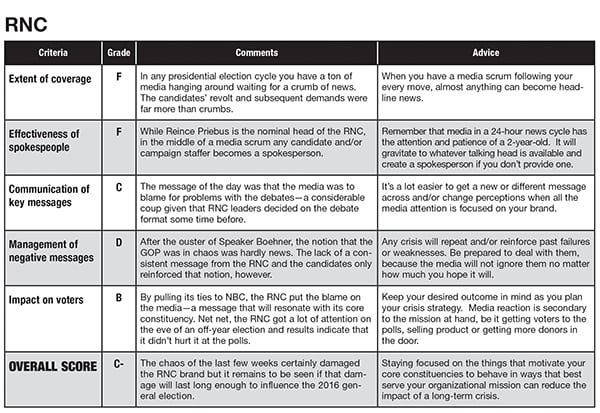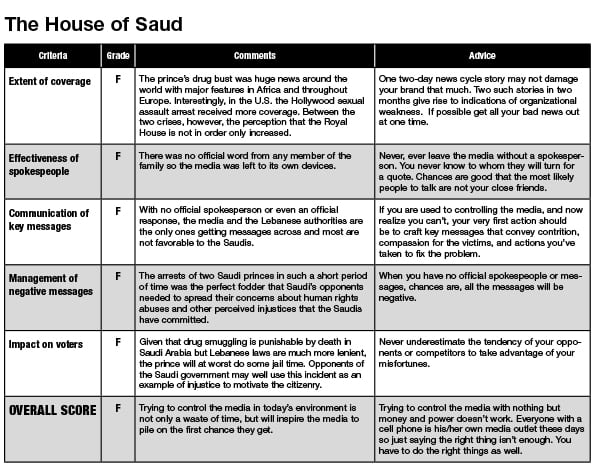In this Instagram / YouTube –fueled media environment, we should know by now attempting to control your message generally leads to more headlines and bad press. So whether it’s just a sign of the times or a sign of mismanagement, two leading brands that have long represented power and control, the Republican National Committee (RNC) and the House of Saud (the ruling family of Saudi Arabia) are in trouble in ways that would be unthinkable a decade ago. Although they operate in the field of politics, they are brands just the same, and like some long-standing b2c and b2b brands, they both have historically ruled their constituencies with command-and-control policies, strictly managing their brands, images and, above all, their communications.
Clearly times have changed.
The RNC
Republican presidential hopefuls’ revolt over debate formats is just the most recent indicator that party leadership is no longer able to control its messages or the membership. Brand favorability is at historic lows, according to the Pew Research Center. After the debacle of the 2012 election, the post-mortem was a 100-page Growth and Opportunity report to which no one seems to be paying attention. The House Freedom Caucus ’ revolt that deposed Speaker John Boehner (R-OH) clearly was a backlash against party leadership. So when the candidates recently staged a revolt against the debate format, it was yet another sign that in these times, attempting to control 55 million Republicans and their respective candidates may well be futile, or further, damaging to the RNC brand.
The headlines out of the debate discussion made the RNC look weak and the candidates appear petty.
Major corporate brands, and numerous politicians, have learned in recent years that the old crisis-management tactics of denial and deflection don’t work. Today when a crisis hits, well-managed brands like Chipotle stress transparency, taking actions that allow consumers visibility into their processes and remedies. Perhaps the RNC should learn from them.
The House of Saud
Social media has long been an issue for the Saudi brand that for decades fiercely controlled the local news media. But all its wealth and oil reserves couldn’t control the news media in late September when a Saudi prince was arrested on sexual assault charges in a tony Hollywood suburb. Things got worse for the Saudi brand when just about one month later a second prince was detained and ultimately charged with trying to smuggle 40 boxes of illegal drugs out of Beirut-Rafic Hariri International Airport on his private plane. And lest the Royal Family try to dismiss the incident as a distant relative misbehaving, the Saudi crest was prominently featured on the sides of the 40 confiscated boxes.
It didn’t help that ISIS fighters frequently use the type of amphetamine confiscated from the prince.
What is most interesting is that for years Saudi wealth and influence squelched the majority of unfavorable news stories. When news of the drug arrest broke, the media speculated that the prince would escape charges due to Lebanon’s dependence on Saudi aid. The severity of the crime, however, turned out to be too serious to afford the prince to get away without a penalty. Needless to say it didn’t take long for the story and photos of the boxes with the Saudi logo on them to go viral on social media.
A few misbehaving relatives or candidates may not signal the end of these formerly formidable command-and-control organizations. Rather, the pressures of YouTube videos and Instagram photographs are exposing the fundamentally flawed foundations upon which these power structures were built.
The reality is that the RNC lacks control over well-heeled candidates, whose funding comes from personal fortunes and Super PACs. As for the Saudis, an October IMF study predicts that due to falling oil prices, Saudi Arabia’s $650 billion in foreign reserves will be gone in five years should its public spending remain at its present high rate.
What we know for sure is that only strong organizations with healthy internal cultures can withstand the slings and arrows that social media is throwing at all institutions these days.
CONTACT: [email protected]
This article originally appeared in the November 9, 2015 issue of PR News. Read more subscriber-only content by becoming a PR News subscriber today.



